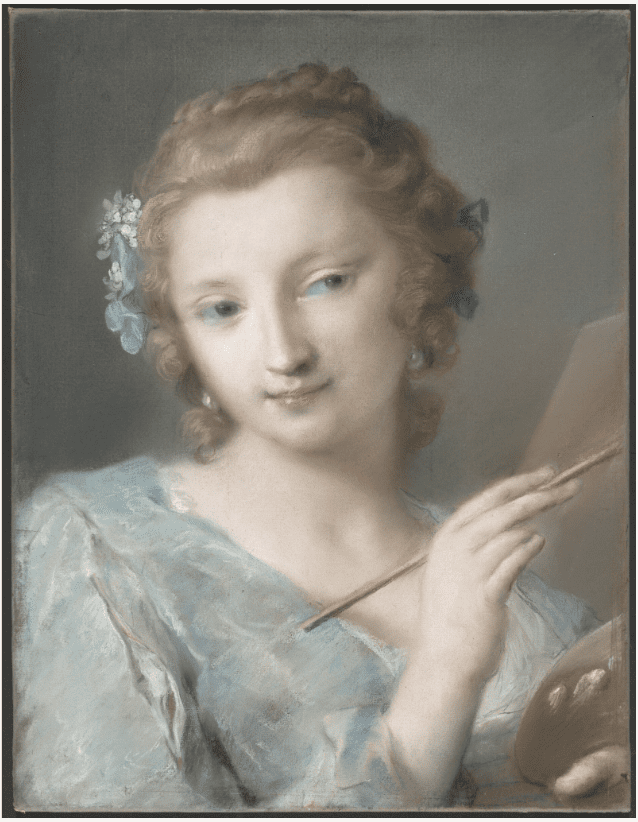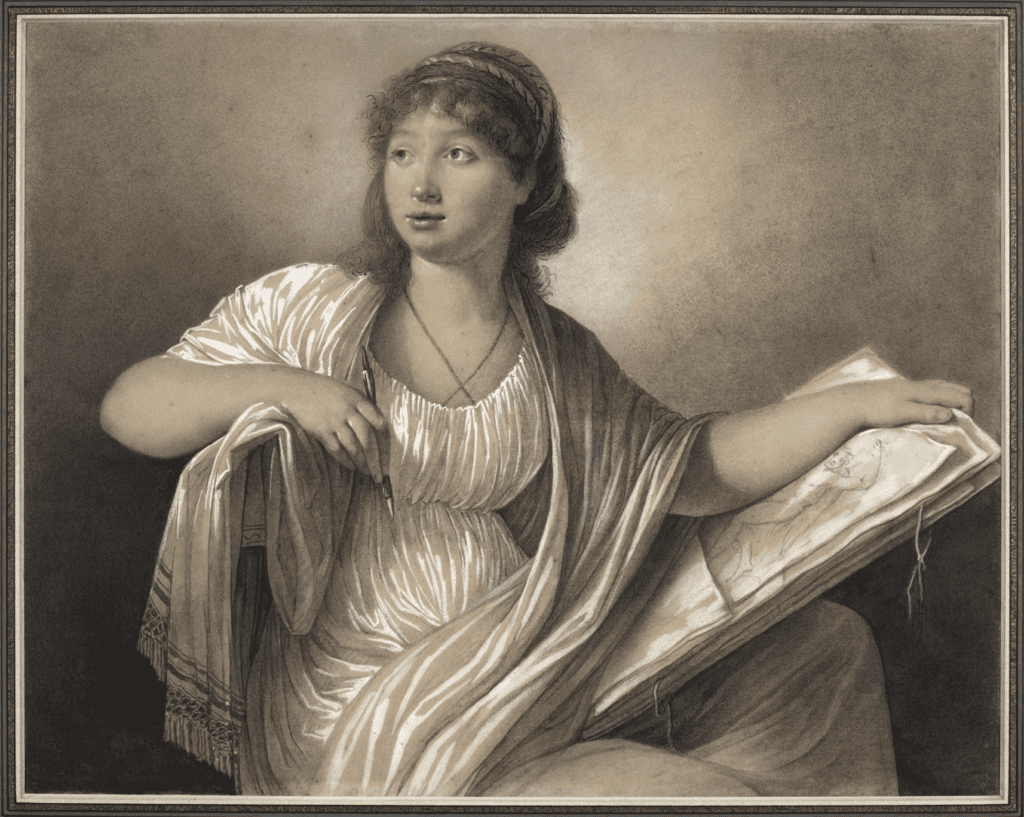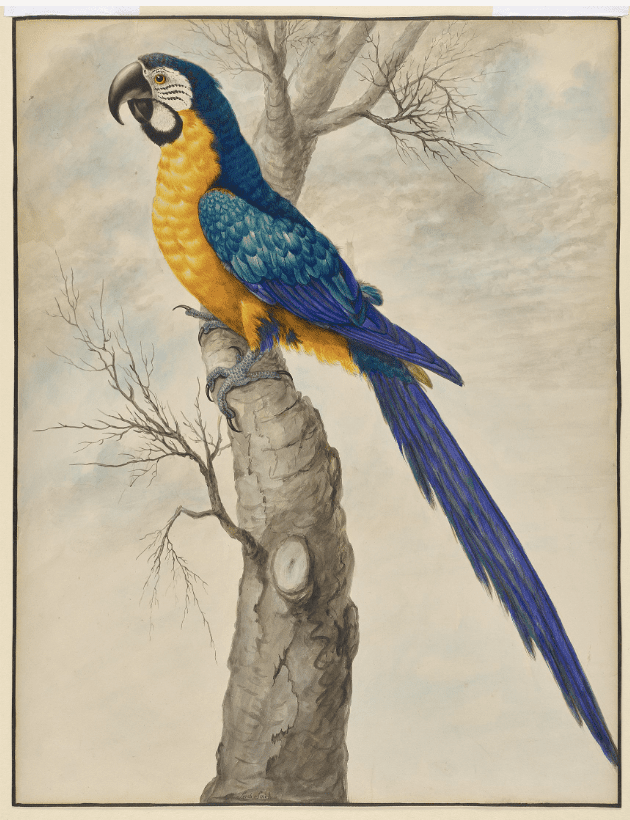Baltimore Museum of Art: ‘Making Her Mark’
By • October 19, 2023 0 2618

“Making Her Mark: A History of Women Artists in Europe, 1400-1800,” at the Baltimore Museum of Art is not only a spectacular walkthrough of artworks from four fervent centuries but a bold re-conceptualization of history itself with its invitation to re-think traditional ideas of European women artists.
While artworks by bold women painters and sculptors have long been recognized, here, they are placed aside exceptional works by lesser-known and anonymous artists as well as the works of many involved in the manufacture of ceramics, metalwork, and cabinetmaking. Through a dozen rooms with a seemingly infinite variety of objects, the case that women artists were (and are) not only as talented as their male counterparts but actively involved in the creation of art is amply made.

“Portrait of a Female Artist with a Portfolio,” by Gueret.
A tapestry “Apollo and Attendants Flaying Marsyas” (1662) by Maria Maddalena della Riviera (Italian, 1611 – 1676, Barberini Tapestry Workshop) is the first to catch the eye as one enters the opening galleries with their rich selections of works under the theme “Faith & Power.”
The broad variety of works on display range from those created for royalty, like Sofonisba Anguissola’s “Portrait of a Boy at the Spanish Court” (1573) to religious themes like Luisa Roldán’s polychrome paint and wood “Education of the Virgin” (1680s) and Artemisia Gentileschi’s “Judith and Her Maidservant with the Head of Holofernes” (c. 1623-25). These are accompanied by objects created for ceremonial purposes — many from nunneries — such as illuminated manuscripts, as well as linen works like Torah Binder (1764-65) by Beila Yehuditah, daughter of Emanuel Finzi di Rivarol.
“Interiority” presents scenes that connect domestic labor and interior decoration. The objects vary from luxurious silver sauce boats and ink wells to an 18th-century wooden cabinet with detailed paper filigree and hair work panel. A variety of samplers, in the tradition of embroidery as an art are showcased as well. Themes range from Geertruydt Roghman’s engravings such as “The Dressmakers and Woman Spinning” (1640-47) with views of women at work to Marguerite Gérard’s oil works, “Motherhood” (1795-1800) and “Young Woman Embroidering” (1815-1820).
An oil on canvas of a woman surrounded by a variety of stringed instruments, Elisabetta Sirani’s “Personification of Music” (1659), serves as a reminder that women artists were not limited to one art alone such as painting — Sirani was also a musician.
Women artists’ interest and involvement in natural phenomena and medical and astronomical sciences is also explored in “The Scientific Impulse.” There are naturalist drawings and paintings of flora and fauna, including Clara Peeters’ oil on wood panel with the lengthy name: “A Still Life of Lilies, Roses, Iris, Pansies, Columbine, Love-in-a-Mist, Larkspur and Other Flowers in a Glass Vase on a Table Top, Flanked by a Rose and a Carnation” (1610 ).
Maria Clara Eimmart looked to the sky for her tempera on paper works like “Lunar phases observed on 29 August 1697” (1693-1698 ) while Pauline Rifer de Courcelles created hard paste porcelain images of birds such as “Le Ministre,” (from “Service des Oiseaux de l’Amerique Meridional,” i.e., the South American Bird Service) (1819-1821).

“A blue and yellow Macaw,” (ca. 1800) by Sarah Stone (1762-1844).
The final galleries on “The Entrepreneurial Spirit” present a further variety of works and materials. In addition to oils such as self-portraits by Sarah Biffin and Judith Leyster, there are the Marie-Victoire Jaquotot’s “Tea Service of Famous Women (Cabaret des femmes celèbres)” (1811-12) and a “lampas” brocaded with silk, linen gown (1775-85) by Anna Maria Garthwaite and Anne Seymour Damer as well as “Shock Dog (nickname for a dog of the Maltese breed)” (1782). All are examples of the businesses of arts production and promotion.
Like the treasury of objects on display, the overall exhibit is a rich treasure to behold.
Exploring themes of faith, decoration, nature, innovation and achievement, this magnificent exhibit runs the gamut from medieval nunneries, through grand European tours, to businesses, surveying over 400 years in 200 royal portraits and devotional sculpture, embroidered objects, tapestries and costumes, along with graphic arts and furniture. The show’s program includes 175 works in the exhibition.
The overall effect is to challenge previous presentations and misrepresentation of women’s achievements and influence in creating art and in the arts industry itself — and to showcase hugely inspirational works across multiple genres.
“Making Her Mark: A History of Women Artists in Europe, 1400-1800,” is at the Baltimore Museum of Art through Jan. 7, 2024.

